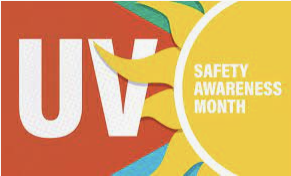 July is Ultraviolet (UV) Safety Awareness Month and the risks of skin cancer and ways to help prevent it should be shared.
July is Ultraviolet (UV) Safety Awareness Month and the risks of skin cancer and ways to help prevent it should be shared.
According to Mayo Clinic, skin cancers are the most common cancer with some 5.4 million new cases reported per year in the US. Approximately 20 percent of people will have skin cancer at some point in their life, with 90 percent of those cases being linked to sun exposure. The most dangerous form of skin cancer, melanoma, accounts for 87,000 cases per year with about 9,000 deaths.
What are UV rays? UV radiation is invisible rays that are part of the energy that comes from the sun and artificial sources, such as tanning beds.
What are the benefits? UV helps the production of vitamin D and vitamin D helps the body absorb calcium and phosphorus from food and assists bone development.
What are the risks? Too much UV exposure can cause sunburn, premature aging and skin cancer, plus without eye protection, UV exposure can cause blinding eye diseases.
If now you’re thinking, “Oh, no, I am doomed!” Relax. The first step is recognition, and then monitoring your skin and vision for changes. Contact your primary care physician or a dermatologist if you think you’re at increased risk or notice changes in your skin. This may include patchy dryness, itching or scaly texture, moles that are irregular in shape or color, wounds that heal and then become irritated again or anything that seems to be growing.
Identifying these issues and early treatment will increase the chance of successful outcomes.
Sheila Trautz, a Mosaic caregiver and cancer survivor, discovered her cancer by accident. After an appointment to have a cyst removed, she told her doctor about a new mole that was itching and scabbing over. He removed the mole and found it was stage 2 cancer. She is now an advocate for skin protection.
While serving on an after-prom committee, Sheila was shocked to discover some of the prizes were vouchers for tanning beds.
“If we are putting tanning beds in the hands of the teenagers, you may as well give them alcohol and cigarettes, too,” said Trautz.
Although this opinion was in the minority, she was able to convince them of the UV dangers associated with tanning beds.
Who is at risk?
• People who are exposed for long periods of time or who have been sunburned
• Those with light-colored skin, hair and eyes
• Those who take medication that increases skin and eye sensitivity to UV rays
• People with a family history of skin cancer
• People over age 50
How can you protect yourself?
• Stay in the shade, especially during midday hours
• Wear clothes that cover your arms and legs
• Protect your children with proper clothing and sunscreen
• Wear a wide-brimmed hat to shade your face, head, ears and neck
• Wear sunglasses that block both UVA and UVB rays
• Use sunscreen with at least sun protection factor (SPF) 15
• Use a lip balm with SPF
• Ensure your sunscreen is not expired or recalled
• Reapply sunscreen every two hours, at a minimum
• Avoid indoor tanning, people who begin indoor tanning at a young age have a higher risk of developing melanoma
• Check your medications and supplements for sun warnings
The ripple effects that Trautz’s bout with skin cancer has had on her own community and family are immense. Through her advocacy, she was able to motivate her brother to be seen where he ultimately discovered he also had melanoma.
“You don’t have to stay out of the sun, but we need to remember to practice sun safety,” said Trautz.




Facebook Comments